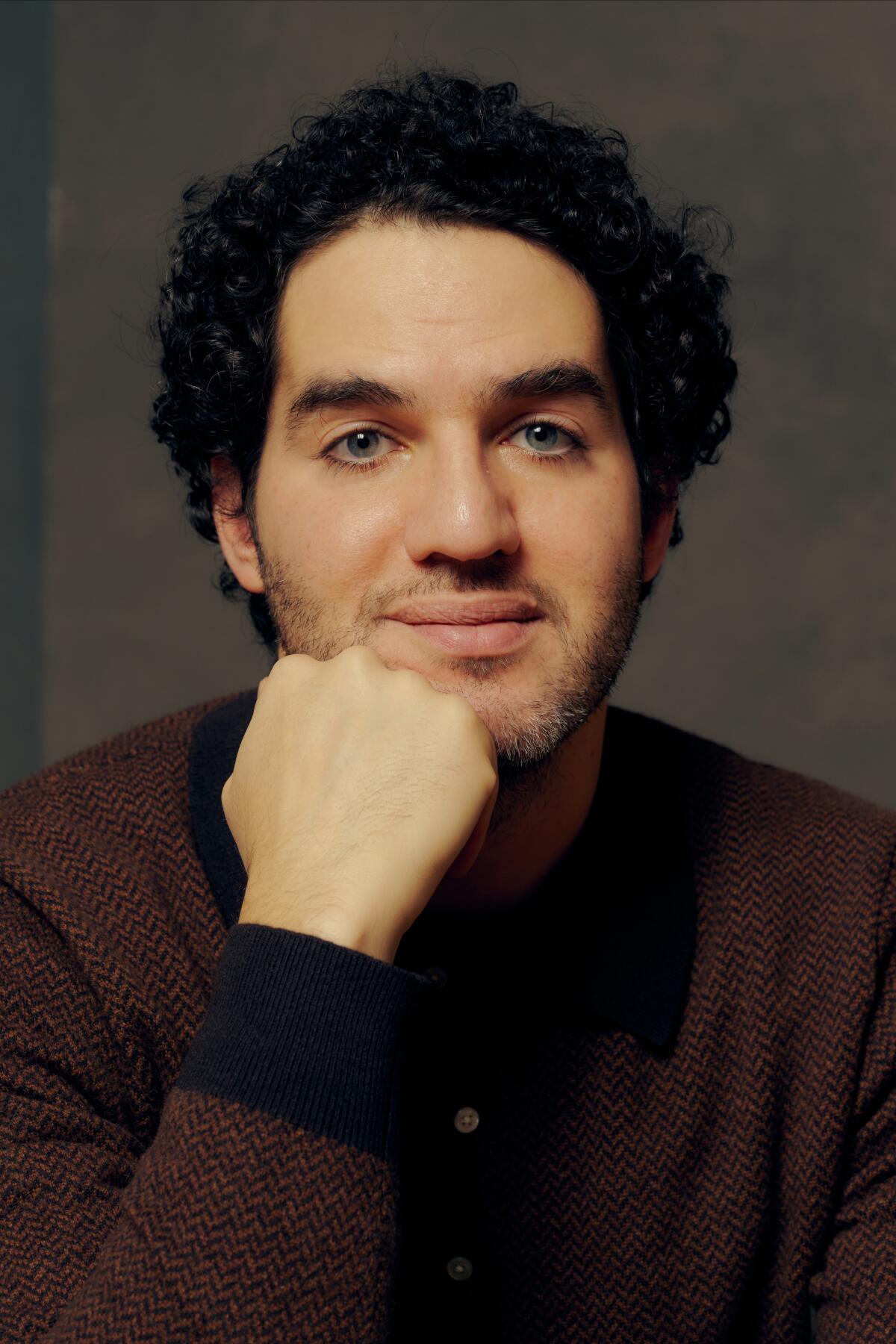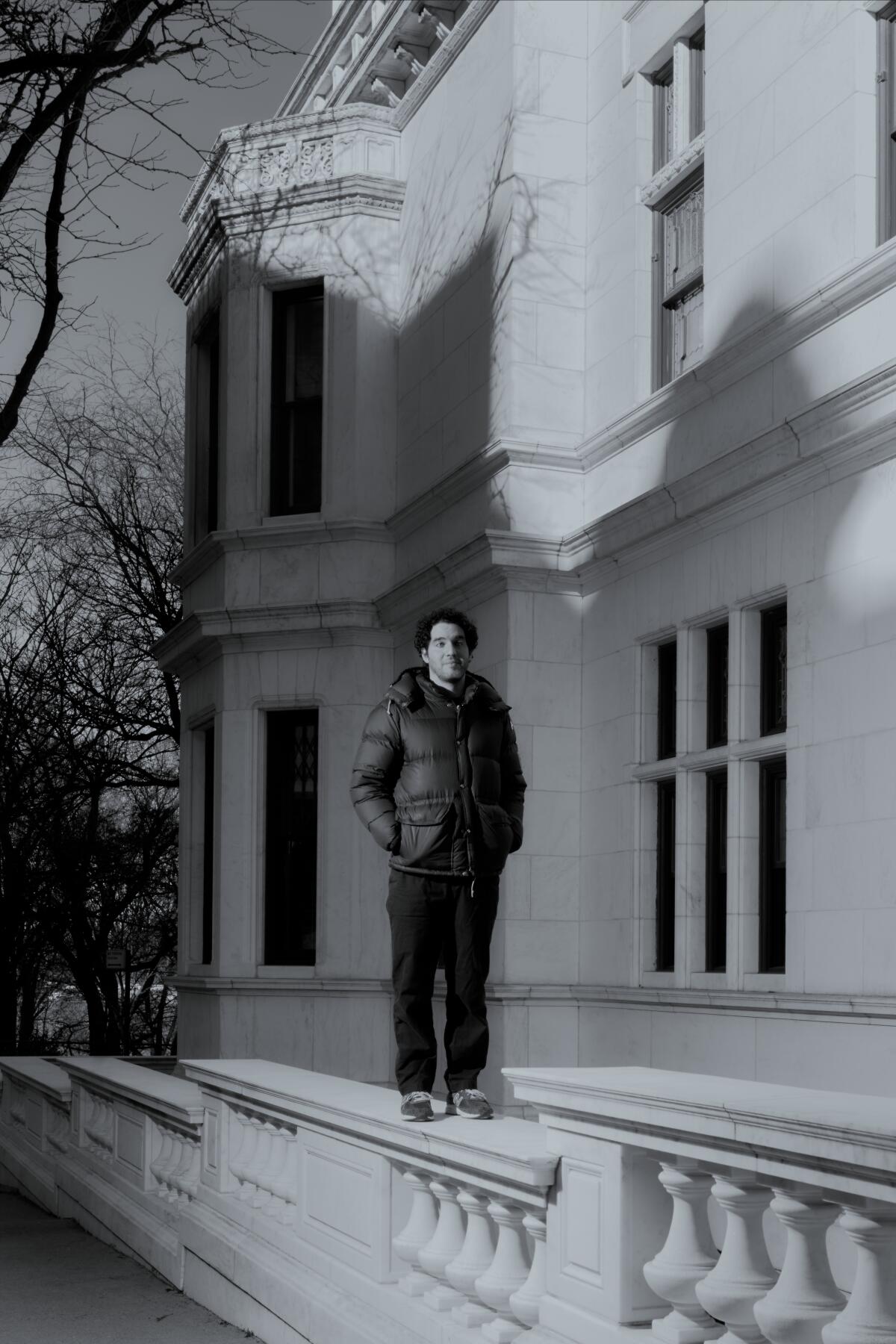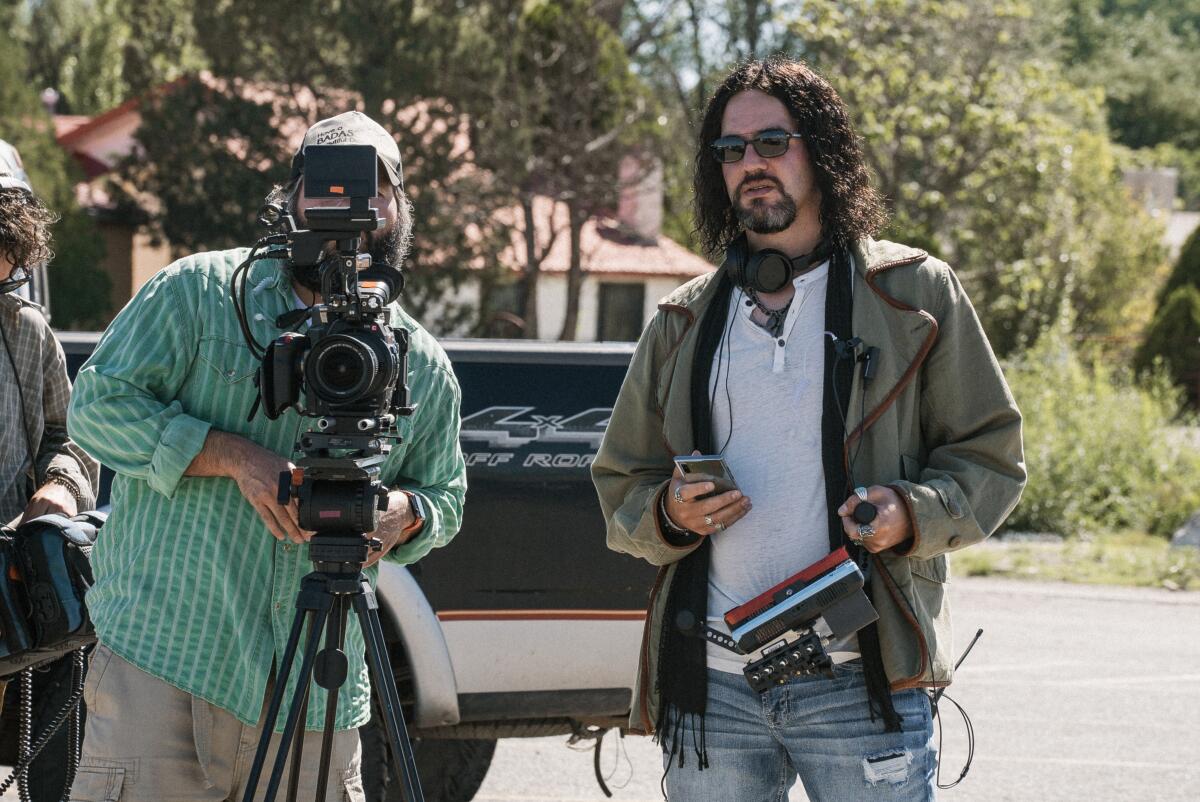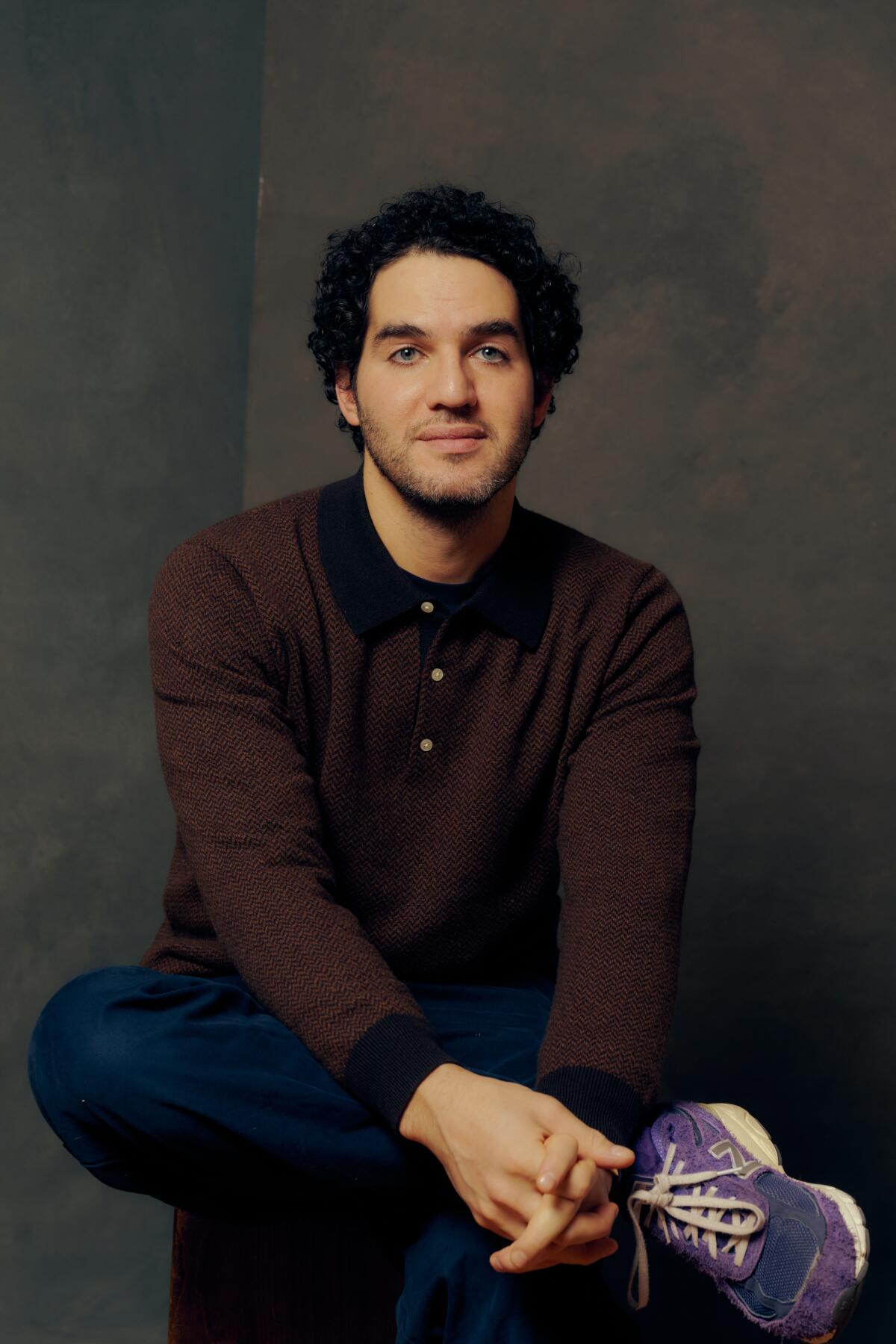The complete guide to home viewing
Get Screen Gab for everything about the TV shows and streaming movies everyone’s talking about.
You may occasionally receive promotional content from the Los Angeles Times.

When Benny Safdie began doing stand-up while in high school in New York City’s Upper West Side, he created a character named Zach Mulden.
Zach’s shtick wasn’t just that he bombed. It was that this character performed so poorly that, as his maker describes it, “His whole point of existence was to go out onstage and bomb.
“Bomb not in a way that was just bad jokes, but bomb in a way that was 100% believable to the audience that this guy had no idea that he wasn’t funny,” Safdie recalls in a recent Zoom conversation. “I would go in dressed in that mind-set, be the guy through and through and talk to people [as him]. That was part of the thing.”
People like to use the term “Kafkaesque” to explain dark and troublesome characters and situations. Safdie’s approach is more Kaufman-esque. Like the late comedian Andy Kaufman, who is one of Safdie’s idols, he thrives on making people uncomfortable.
“When you feel uncomfortable, it’s almost like you’re feeling somebody else’s emotions,” Safdie explains.

He says that with a lot of media, “The work is doing a lot of things to come to you [with] as minimal effort on your part as possible. … I think that it is important for you to kind of be pulled off of your seat to wherever you need to go. You need to see people’s awkward silences; you need to see people feel uncomfortable. But in addition to that, you need to understand why they’re feeling that way. So you need to have seen the context that got [them] to that place.”
This need to let the uncomfortableness fester and relish the minutia has long been part of Safdie’s career ethos. “I’m very obsessed with realism and what that does to people when they watch it, or experience it,” he says.
Rising to notoriety through the indie film world with his brother and filmmaking partner, Josh, the Safdie brothers — as they’re colloquially known — created projects like the Robert Pattinson-led family crime drama “Good Time” and “Uncut Gems,” a critical darling that cast Adam Sandler as an indebted gambling addict working in New York City’s jewelry district. (It also gave actress-model Julia Fox her breakout role as the paramour of Sandler’s character, Howard.) And Safdie also made scene-stealing meals out of some acting roles: In addition to starring opposite Pattinson in “Good Time,” he is known for portraying a young Joel Wachs, the long-serving L.A. City Council member and mayoral candidate, in Paul Thomas Anderson’s “Licorice Pizza.”

But if you’re going to pinpoint exactly when Safdie’s name went mainstream, it probably would be 2023.
Himself broad-shouldered with full eyebrows and a pile of thick, dark hair, he played the lumbering turncoat/comic relief Edward Teller in writer-director Christopher Nolan’s “Oppenheimer” and the best dad a kid could hope for in writer-director Kelly Fremon Craig’s adaptation of the Judy Blume novel “Are You There God? It’s Me, Margaret” — a story that teaches acceptance of others’ religious ideologies as much as it does of menstruation and puberty. A few days after this interview, it was announced that Safdie would direct Dwayne Johnson in a biopic about Mark Kerr, the MMA fighter also known for his addiction to painkillers.
On television, Safdie and his brother were executive producers of the HBO documentary series “Telemarketers,” which was directed by Sam Lipman-Stern and Adam Bhala Lough. Using archival footage that Lipman-Stern shot of himself and his former co-worker Patrick J. Pespas, the miniseries exposes a telemarketing scheme in such a profound way that it rises through several federal agencies and the halls of Congress.
The amateur sleuths behind HBO’s docuseries took their investigation of telemarketing scams to Sen. Richard Blumenthal. Here’s what happened next.
And he also partnered with “The Rehearsal’s” Nathan Fielder — another talent whose brand is uncomfortable — to create the Showtime series “The Curse.” Starring Fielder and Emma Stone as Asher and Whitney, a couple attempting to make an eco-friendly HGTV show, and Safdie as Dougie, their director and Asher’s childhood frenemy, “The Curse” is a cringey examination of how some good intentions can have extreme side effects. (In his review, Times TV critic Robert Lloyd noted that “The Curse,” which is currently airing weekly, is “not a comedy and doesn’t seem to want to be. Yet many of the incidents could, with a few adjustments, launch an episode of ‘Curb Your Enthusiasm.’”)
“I don’t think we evaluate things in terms of ‘awkward’ or ‘extreme,’” Fielder tells The Times via email. “There just has to be a core honesty to each moment. I feel a lot of the discomfort is coming from watching characters that care too much. How honest that caring is to the characters is up for debate. But there is a palpable and real desperation to be better, in some form, but without the path of how to get it done.”

He adds, “When the execution fails, these painful fissures end up forming interpersonally between people. These moments came out of the writing, and as the characters get more desperate, they take bigger swings. I see it all the time in real life. And it felt like rich territory for the show.”
The impetus for “The Curse” was a real-life event — similar to what happens to his character, someone told Fielder he’d been hexed when he’d refused them charity and he then felt the need to rectify the situation — and Safdie’s own obsession with home-flipping programs, especially the ones that don’t acknowledge their culpability in gentrification. He remembers watching a compilation of these shows on a plane ride to Los Angeles. One had the slogan “If you don’t like your neighborhood, change it.”
“Reality TV, it’s always brushed off as this kind of non-nothing medium, but a lot of my inspiration comes from that kind of stuff,” Safdie says. He name-checks programs like “Judge Judy’’ and “Kitchen Nightmares” before continuing, “You have these characters who are in a framework. But because it’s so perfectly manicured, it has a formula.”
Showtime’s “The Curse” was co-created by Nathan Fielder and Benny Safdie, who also star in the series alongside Emma Stone.
He and Fielder also talked about inverted detective stories like the classic Peter Falk series “Columbo,” programs that tell you what happens at the beginning so you’re not so much guessing who committed the crime as learning why they did it.
“It becomes a study of human emotion: How does that person look guilty? How does that person lie?” Safdie says. “These are all really interesting things because, if we think about it, when you see somebody lying — and you know they’re lying — you know that person better than you ever have.”

He applies this logic to the guilt of lineage that Stone’s Whitney experiences in “The Curse.” She desperately wants to distance herself from her wealthy parents (played by Corbin Bernsen and Constance Shulman). But she also uses that privilege to make her feel superior to them, buying friends expensive things they didn’t really want or personally paying shoplifters’ tabs when they steal from her store instead of pressing charges.
“When you look at somebody and they’re doing the right thing, that should be enough for you because, hey, the end result is that they are [helping],” Safdie says. “But when you go further, as a human being should, you see potential, and you see reason and you see motive.”
It was imperative to Safdie that “The Curse” use jazz legend Alice Coltrane’s hypnotic and soaring meditation music as an overlay to the making of Whitney and Asher’s fictional show and other images in the very real filming location of Española, N.M. Safdie says he even wrote a letter to Coltrane’s son, jazz saxophonist Ravi Coltrane, and the estate’s lawyer, telling them, “When her songs come in, in the show, it’s not judging what’s happening. But it almost exists like an emotional closed-captioning.”
“The music is there to not even clarify anything, but it’s putting you in a state of mind to maybe see a path,” Safdie says. “I think that’s what’s so important about her music, in particular, because it does feel like she had access to something that I’ll never have access to. And I’m in awe of that. She was able to not only verbalize it but make such beautiful music with the organ and the harp.”
Safdie, who says he almost became a physicist, compares Coltrane’s music to string theory, noting, “There’s all these vibrations that exist and then they form bigger things.”
Some audiences have questioned if “The Curse” is a conversation on Jewish mysticism, as both Fielder’s and Safdie’s characters have (like them) Jewish heritage and Stone’s character is a Jewish convert. It also was promoted with the premise described as “how an alleged curse disturbs the relationship of a newly married couple as they try to conceive a child while co-starring on their problematic new HGTV show, ‘Flipanthropy.’”
Safdie says the logline wasn’t his and Fielder’s idea, but “Judaism is a big part of the show,” he concedes.
“Judaism, what I like about it is, there’s a lot of concepts within it that aren’t necessarily religious,” he says, giving the example of breaking a glass at a wedding. The tradition has different interpretations, but he says he was taught that “at the happiest moment in your life, we are going to break a glass to remind you how fragile that moment is, and that there’s sadness and basically that everything could fall apart.”
He also thinks there might have been something kismet about filming in this area of New Mexico, where locals like Edward Martinez readily offered their own businesses and homes as locations (Martinez also ended up with a small part on the show, playing contractor Freckle). It also meant that the creators could use their platform to discuss actual conditions experienced by Native people, specifically those who live in a pueblo near Española, an irony given that this is a goal Stone’s tone-deaf do-gooder wants for her renovation show.
“Once we settled on Española, we knew we were going to dive head-on into a lot of things that would be problematic to talk about,” Safdie says. “Even though we picked it, we felt forced. Once you’re there, you really have to understand it. We wanted to tell the most realistic portrayal of the town for them.”
“The Curse,” as well as “Oppenheimer,” which also was largely filmed in New Mexico, meant Safdie had to challenge himself artistically too. Most of his projects until now heavily relied on New York City’s unique realism. Not only did he have to adjust to a more laid-back pace in the world beyond the Hudson River — a day of running errands before heading to set for “The Curse” was derailed because the place that made the egg sandwich he liked was too swamped to do takeout orders — he says, “There was something really awesome about being able to explore a new place and a new landscape. There’s browns and there’s all these new colors there.”
And while Safdie does acknowledge that his projects from this year come with some kind of social or political message, it is not necessarily his intent to create culturally conscious content.
“As you make the project, you’re just doing it,” he says. “When it’s done is when you can kind of sit back and understand where a lot of this stuff came from.”
With “Telemarketers” specifically, he says, “I liked the message that these guys tried to stand up to power.”
“I’m so proud of where that ended up with that show because it really does speak to this idea that you could have taken that exact same footage and cut together some kind of weird Christopher Guest-style thing — and I love Christopher Guest. But that wouldn’t be right for this, because I don’t want to make fun of anybody,” Safdie adds. “A lot of the time, I’m watching an edit and I’ll be like, ‘OK, let’s not put that in there’ because it’s gonna hurt people’s ability to connect and they’ll be able to write off the character too easily.”
He’s also inspired by the early work of British writer-director Mike Leigh, noting that in those films, “When somebody leaves the room, what happens?

“It’s just studying human behavior,” he says. “Looking at humans like that, inevitably, you’re going to come into the moral question. Because that’s what you do every day, right? You’re constantly making these minor judgments of whatever it is.”
The irony may be that Safdie says all of this while looking extremely comfortable himself. He’s wearing a large white sweatshirt that his wife, Ava, gave him. It has a picture promoting the Super Fight, a 1987 boxing match between Marvin Hagler and Sugar Ray Leonard.
An avowed boxing fan, Safdie says, “There’s something about that camaraderie that I find endlessly inspiring; that you can get punched in the face and say thank you to the other person at the end of the day.”
But this fight is particularly noteworthy, he says.
“Marvin Hagler, when he got the draw in this fight, he quit, because he realized, ‘I won that fight. I know I won that fight.’ And he was so upset that they didn’t give it to him, he just stopped boxing,” Safdie explains, adding, “He knew he was comfortable enough to make that decision, and be authentic to himself, and move on.”
The complete guide to home viewing
Get Screen Gab for everything about the TV shows and streaming movies everyone’s talking about.
You may occasionally receive promotional content from the Los Angeles Times.